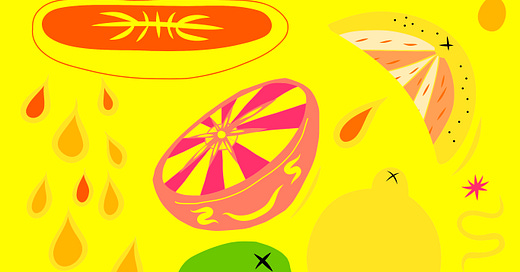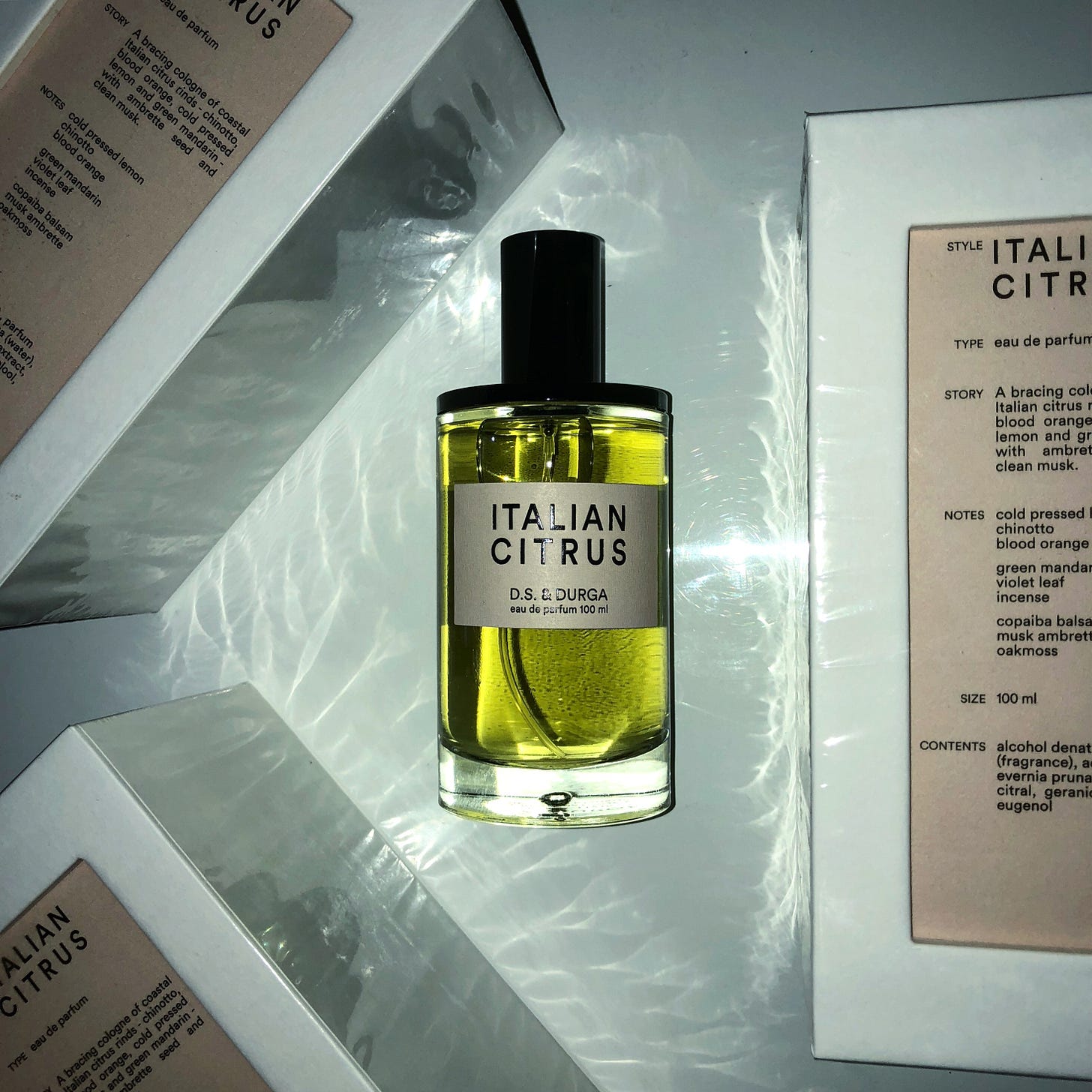Clementine bags are back at the front of supermarkets. Grapefruits are gracing the breakfast tables of our 20th century fantasies. Lemons are squeezin’ till the juice runs down our legs. It’s citrus season! I am a massive proponent of wearing citrus perfumes in winter, so I thought it’d be appropriate to share my most used citrus & citrus adjacent oils.
Citrus oils are the top note stars of perfumery. They are fresh, acidic, bracing, & familiar. Citrus is the best announcement of what is to come - the overture to the aromatic symphony just beginning. Sometimes they are the main character (in light colognes), but more often they are there to support other stars. For those with synesthesia or a sensitive schnoz, citrus oils very easily match up with any colorful aromatic idea – lime gets you green, orange, orange and so on. They are among the easiest to aromatically “paint” with.
I find that citrus oils vary from crop to crop even more than most other natural materials. You can really obsess about the origin and location of a particular citrus, but like wine there will be fluctuations. Hopefully this can be seen as an interesting, living element in our perfumes. I remember when Mexico had a majorly hot year, and the lime oils cooked. It effected the price, but also the quality of the oil, which was as the French say, “pretty neat.” For those who want to be aromatically literate, getting to know the difference in terroirs of citrus is useful. California lemons vary from Italian ones, but both can serve up the top yellow acid focus when you need in the top note sections of your fume.
Citrus oils are famously volatile. They breakdown & dissipate easily. For the perfumer, they are not generally oils you want to age. We’re looking for freshly expressed or distilled oils that enliven our creations. Some aged citrus gets a sinewy, rubbery effect as time goes on and can be used in heavier genres like chypre. It is not easy to get citrus to last in perfumes, but there are a few great molecules that mimic citrus to help with this (most of those ones have fruity or floral aspects and won’t be covered in this citrus forward article, however).
Here are the citrus materials that live in my perfume organ.
Bergamot
The king. Bergamot is perfume. The fresh yellow, green bitter profile never gets old. The more you smell it, the more facets you discover – fruiter, muskier aromas build upon its mysterious effervescence. The most import top note in perfume. Combine with moss & labdanum to make chypre. With lemon, herbs, & neroli to make cologne. It goes with everything & adds intrigue in the top note section of anything it touches. Bergamot is a hybrid between citron & bitter orange – 2 of the finest citrus notes in perfumery. Here the sum of the parts made historic magic.
Cedrat (citron)
A unique sugared lemon from the Mediterranean. Recalls lemon candies & liquors in an elegant way. Provides interest in place of or in addition to lemon. To me, cedrat lasts longer and can be perceived far after other citruses are gone.
Citral
A basic building block found in everything “lemon” – lemon grass to ginger. Important to fortify citrus oils & accords. Useful with rose & incense, and classic cologne ideas. Old fashioned. Cheap!
Clementine
Clementine oil is sourer than oranges, with a background of violet toned anise. It might be the most gourmand of the orange citruses – it recalls candy and can be a nice fresh top note for vanillas & desserts. It is downright delectable in ambers like tolu, benzoin, & cistus.
Grapefruit
Effervescent top note with wonderful floralcy. Screams pink or yellow and sustains freshness. Always a lovely choice with fruit & flower, but fun with woods, moss, & musk as well. It lives in harmony with vetyver especially.
Lemonile
A rosy-lemon material that reminds one of lemon petitgrain (the distilled stems of lemon). Like most nitriles, it is strong stuff. Lemonile has a sweetness that approaches cedrat. It can help enliven woody ideas (a lemon pledge association?) and is at home in orange blossom or rose hearts.
Lemon
Like all citrus, it’s good to sniff oil from different places. I use Italian lemon a bunch. It is a bit sweeter than the sourer California oils. Lemon is a secret way to boost the fresh top note section of a perfume. Of course, too much makes an obvious statement. But like food, a little acid sometimes brings up other flavors with it. Orange and lime really announce themselves. Lemon has a way of letting other notes dominate.
Lime Oil (pressed)
The pressed oil of limes gives us the real-life aroma of the fruit. It is obviously the best citrus oil for announcing “green” in the top of perfumes. Lime is just so interesting that it can make unique accords with woods, flowers & of course it does well in sports fragrances. I use bits to brighten green landscapes and forests. Lovely with vetyver too.
Lime pressed (sesquiterpeneless)
This is a unique, pure specialty that I use all the time. Wonderful to head up the top notes of all fine perfumes calling for lime. Exceptional in cologne, chypre, and fougere. Harmonizes well with bitter orange and bergamot to make ritzy fumes for well-dressed dandies. It’s important in The Carlyle perfume I made.
Lime Oil (distilled)
Here is the fragrance of candy lime. It smells just like fruit loops cereal. That sweetness works well with gourmands, ionones, vanillas, and even some ambers. Distilled lime smells more old fashioned, so it can be used to recall old heady florals and violet perfumes. It’s the lime of Burning Barbershop.
Lime Oxide
A functional fresh aroma that recalls Indian lime pickle or Persian lemon. Small amounts freshen soapy scents. Many Oxides have a harsh dirty edge that I find work when cut with woods. Lime oxide can help make sandalwood accords more realistic.
Litsea Cubeba
A natural source of Citral, also called May Chang. Like lemon grass, it has a spicy green shade which works with grass, colognes, flowers and fresh plants. Too high of a dose moves you closer to bug spray.
Makrut Lime leaves
Makrut lime makes me sick & I have never used it in a perfume. When I first smell it, I feel as though I am dying in a vat of Fabulosa & Pinesol. But its power is of course useful. Makrut has a pink, rosy sheen over a nauseatingly strong green floor cleaner aroma. As it dries down, the woody leaf background nicely supports what would otherwise be pure kitchen floor. Maybe one day I’ll try to make something with it!
Mandarin Oil
A joyful oil that brings sweet floral fruit to top & heart note sections (and sometimes lasts even longer). It is fancier than orange. Good oils have a salty sea and brown off-note that recalls clams. Yep! Mandarin’s marine-animalic facet harmonizes with rich flowers like jasmine, gardenia, and rose. Mandarin smells thicker than orange with a pleasant minty dryness that works well with chalkier, earthy materials like oakmoss. It is an elegant top note in old world fumes too.
Orange terpenes
A mixture that includes dominate orange aromachem d-limonene. Fresh, sweet orange peel notes. An old perfume world basic still kicking today. Beyond citrus accords, it blends well with green herbs & grasses, ambers, and dark woods especially atlas cedar.
Orange, Bitter
Also called Bigrade, this is the preferred orange of perfumery. Bitter orange is extracted from the fruits of the citrus auranatium, a mouth wateringly complex orange. Orange bigrade is to orange as bergamot is to lemon (more interesting for perfume). It is thick and floral, with a fineness you don’t find in regular oranges.
Orange, Blood
Blood orange is a beauty – halfway between grapefruit & tangerine. It is sweeter & photorealistic – you can smell the pith of the orange. It is the star of my Italian Citrus, tying together the kaleidoscope of coastal Italian citrus rinds into a deep glassy fresh bow. It goes well with petal accords of rose, tree flowers, flowers of the meadow, orange blossom, & even gardenia.
Orange, Brazilian
I have a nice cold pressed Brazilian orange oil. I use it a lot…for cleaning grime off of bottles. I rarely reach for regular orange oil in perfumes. Unsurprisingly it smells of oranges. There are many varietals, but I end up using bitter, mandarin & tangerine much more than them.
Nootketone
A very expensive derivative of grapefruit oil with a throw of arresting beauty. It gives a special oily vibration like ambrette. It is a note you will find in fine woods as well like buddahwood, mahogany, & rosewood. As time goes on, it takes on a distinct rubbery facet you find in grapefruit & buchu. Nootketone is useful in fancy skin scents & for building up vetyver accords.
Tangerine (Cravo type)
This oil is like Mandarin but without that clam note. Which is to say very fine red powder over coral orange. Tangerine smells like what an orange wants to be – more orange than orange. We’re so used to oranges that they can come off pedestrian in fancy perfumes. Tangerine is a dressed-up orange with a perfect balance of zest & sweetness. Watch for a sandy note in the drydown that pairs unbelievably well with incense.
Yuzu absolute
I can never see tiring of yuzu’s sour flower piney lemon vibration. It always enchants the nose. Like wintergreen-pine on bergamot with orange flower bitters. It can work lovely in fern, moss, and cologne. Since it is a newer material in the perfumer’s palette, it smells more “exotic” than other citrus to many people. Yuzu is useful in weird perfumes that need a touch of Sulphur – say recalling the inside of a stereo, the operating table at a doctor’s office. A great citrus oil for a snowstorm too. And grey cement. It’s got a lot going on.
Stay fresh!







This was great winter morning reading. One of the core olfactory memories I have comes from clementines in winter. I grew up in New England and our house was primarily heated by wood stove. We’d put the clementine peels on top of the stove to dry out and then throw them in, where the oil would make them flare up and burn out quickly. But the whole woody, smoky, acidic, bright, smoky twang of that was wonderful.
Your Pomelo Blossom fragrance from 15(?) years ago is what introduced me to your brand, would love to know how you'd approach pomelo today!